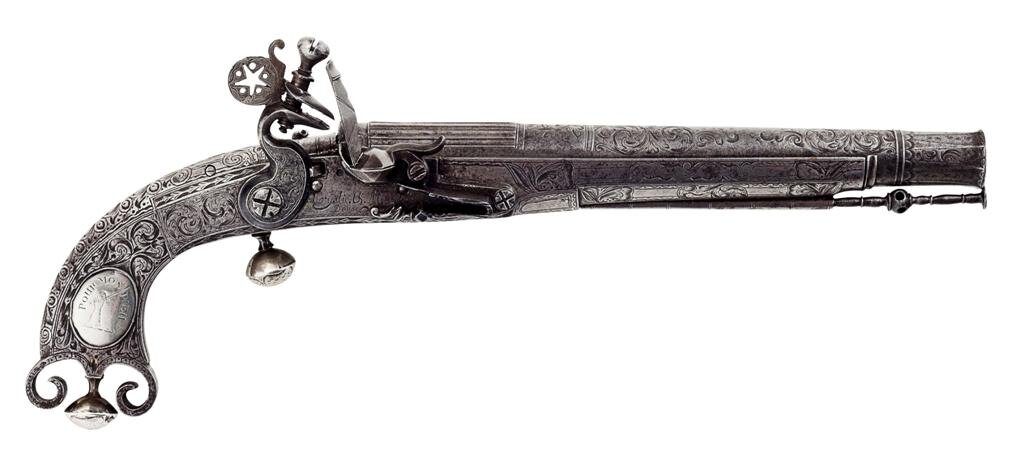Firearms
Snaphaunce Pistol
Period: 1610 AD
Length: 40cm / 16”
Scottish firearms developed in distinctive style during the 16th and 17th centuries.
The Pistol was much handier than the long flintlock musket of the time which was too large and cumbersome for war.
Scottish flintlock pistols were unique in that they were all steel and they were very popular weapons with the Highlanders.
Some of the influences are described of as Middle Eastern appearance. Pistols were made of steel or brass with silver inlay.
The pistol butt came in a variety of shapes such as fish-tails, lemons, hearts and scrolls.
The Snaphaunce Pistol is fitted with a simple firelock mechanism. This would be one of a pair with the lock mechanism of the pair reversed. The construction is of brass and the butts are fitted with a lemon shaped extension. Like all firearms of this period the pistol is muzzle loaded.
Doune pistol
Period: 1720 AD
Length: 30 cm / 12”
In the 17th and 18th Century the town of Doune became a centre for the manufacture of high quality firearms.
The unique characteristics of a "Doune" pistol included the use of a cast iron stock rather than the more usual wooden or brass stock.
This allowed considerable scope for ornamentation with engraving and inlay.
The firing mechanism, or lock, is of the flintlock or snaphaunce style. The flint attached to the hammer strikes the steel frizzen plate causing sparks.
A small quantity of powder placed in the pan ignites and passes through a touch-hole in the barrel to ignite the main charge in the breech behind the bullet.
The Doune pistol is recognisable by the curved ends of its metal stock.
Heron Butt Musket
Period: 1680 AD
Length: 1.5 metres / 60”
Muskets and fowling guns from early Scottish manufacturers had a distinctive design with a large paddle-shaped butt and deeply carved flutes set in the curve of the stock.
This design was also known as the "Heron Butt". The guns were usually fitted with large snaphaunce lock mechanisms.
The word 'Snaphaunce' is said to be derived from the Dutch 'Snap-haens' or chicken thief.
Another theory is that it refers to the falling cock or hammer being a similar action to a cock pecking.
This in German is 'Schnapphann'. With this type of mechanism the flash-pan has to be uncovered by hand before firing.
In later flintlock designs the pan is opened automatically by the flint striking the cover.
Flintlock Musket
Period: 1710 AD
Length: 1.5 metres / 60”
The flintlock musket comprised three separate items, often made independently.
The lock is the firing mechanism, during this period is generally of the firelock variety.
It is fitted into the wooden stock which rests against the shoulder and which also supports
the barrel.
This combination gives rise to the phrase, "lock, stock and barrel".
The stock of the musket is made from carved walnut with a distinctive raised butt.
The flintlock assembly is of steel and brass and set in the stock.
The steel barrel is supported by the stock and below it is a ramrod used to prime the musket with powder, wadding and shot.
The pan of the lock is then primed with fine powder and the hammer cocked in preparation for ignition by the striking flint.
Field Cannon
Period: 1580 AD
Length: 1.4 metres / 55”
Width: 40 cm / 16”
Largely due to the difficulties of transport over rough terrain, cannons were not extensively used in Scotland. BUT they did contribute to the government victory at Culloden.
Cannons built at the Carron works in Falkirk were later to gain a worldwide reputation and were used in many naval battles.
This field gun is typical of a type cast in Edinburgh in the 1500's to 1600's.
The gun would have been built to order for a highland laird and installed to protect a castle or stronghold and is mounted on a rough wooden carriage.












